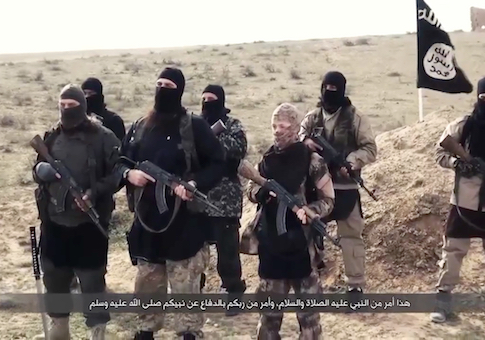ISIS posed the greatest threat to the globe last year, the State Department concluded in a comprehensive report on terrorism issued Thursday.
The agency’s Country Reports on Terrorism 2015 paints an alarming picture of the increasingly decentralized terrorist threat worldwide that yielded deadly attacks in Paris and elsewhere last year. The report focuses on ISIS’s violence and human rights abuses, which persisted despite its territorial losses.
"The global terrorist threat continued to evolve rapidly in 2015, becoming increasingly decentralized and diffuse. Terrorist groups continued to exploit an absence of credible and effective state institutions, where avenues for free and peaceful expression of opinion were blocked, justice systems lacked credibility, and where security force abuses and government corruption went unchecked," stated the report, issued by Justin Siberell, the agency’s acting coordinator for counterterrorism.
The report concludes that ISIS presented the gravest threat as it looked to expand holdings in countries such as Libya and Afghanistan and also inspire and wage attacks on Western nations.
"The Islamic State of Iraq and the Levant (ISIL) remained the greatest threat globally, maintaining a formidable force in Iraq and Syria, including a large number of foreign terrorist fighters," the State Department wrote, using another name for ISIS.
While the U.S.-led coalition has estimated that ISIS’s holdings diminished by 40 percent in Iraq and 20 percent in Syria after reaching a high point last spring, the report notes that the terror group has demonstrated an ability to expand attacks outside its territory in the Middle East.
"Toward the end of 2015, ISIL fighters conducted a series of external attacks in France, Lebanon, and Turkey, demonstrating the organization’s capabilities to carry out deadly plots beyond Iraq and Syria and also exposing weakness in international border security measures and systems," the State Department wrote. "These attacks may also have been staged in an effort to assert a narrative of victory in the face of steady losses of territory in Iraq and Syria."
Among ISIS’s attacks last year were the coordinated attacks on a concert hall, major stadium, and several restaurants in Paris last November. The bombings and shootings killed 130 people and left hundreds wounded. The report notes that France in particular "confronted serious terrorism threats in 2015, including the mounting challenge of foreign terrorist fighters."
"The return of French nationals who joined groups fighting in Syria and Iraq is a major and increasing threat," the report states. "On December 15, Interior Minister Bernard Cazeneuve estimated that 1,800 French citizens or French residents were linked to fighting among violent extremist groups in Syria and Iraq. Of them, Cazeneuve estimated 600 were in Iraq and Syria, 144 had died, 250 returned to France, more than 500 were preparing to depart, and the remainder were in transit."
The United Kingdom said it thwarted seven attacks inspired by ISIS inside its borders last year, the report stated.
Loss of territory has adversely affected cash flow to the terror group, which accumulates revenue from oil smuggling, kidnapping for ransom, human trafficking, stealing, and other criminal means. Still, as ISIS has relinquished ground in Iraq and Syria, it has built support in Libya, Afghanistan, and Pakistan.
The terror group made gains in Libya during the second half of 2015 and is estimated to have as many as 5,000 terrorist fighters based there, the report notes. ISIS also established a branch in Afghanistan and Pakistan, known as the Khorasan Province or "ISIL-K," which the State Department formally designated a terrorist organization in January of this year.
ISIS also posed unprecedented challenges to governments fighting the group with its use of technology to recruit supporters and encourage attacks.
"Beyond affiliated groups, ISIL was able to inspire attacks in 2015 by individuals or small groups of self-radicalized individuals in several cities around the world. ISIL’s propaganda and its use of social media have created new challenges for counterterrorism efforts," the State Department report states. "Private sector entities took proactive steps to deny ISIL the use of social media platforms by aggressive enforcement of violations to companies’ terms of service."
Over 50 individuals were arrested in the United States last year for plotting with or attempting to support ISIS, according to a December report from George Washington University. The terror group is also suspected of inspiring the December shooting attack on a San Bernardino, California, holiday party; ISIS has claimed that the attackers, a radicalized married couple who later died in a shootout with police, were "supporters."
The State Department’s assessment comes as the U.S.-led coalition continues to support local forces in Iraq and Syria as they battle to seize key territories from ISIS. Iraqi forces have begun a mission to retake Fallujah, the first Iraqi city captured by ISIS more than two years ago. ISIS has fought back, reportedly using hundreds of families trapped in the city as human shields.
Meanwhile, the terrorist threat in Europe and elsewhere remains high. Earlier this week, the State Department issued a travel alert to Americans planning trips to Europe, warning of potential terrorist attacks targeting major events, tourist sites, and transportation hubs.
